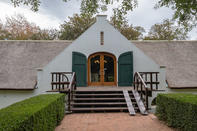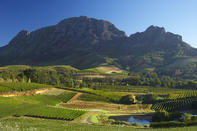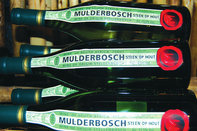There are a number of beautiful wine estates across the Stellenbosch Region, rich in history and culture. The wine estates are leading producers in top-quality South African wines that have gained international recognition. The Stellenbosch Wine Route is divided into 4 sub-routes, so visitors can enjoy a large choice of wineries at one of the Western Cape’s most popular tourist destinations.

Rustenberg Estate
For wine pedigree, look no further than Rustenberg. The estate was founded in 1682 at the sharp end of Ida's Valley, Stellenbosch, and the first Rustenberg Wines were bottled back in 1892. The estate stands on an impressive 880 hectares against the iconic Simonsberg Mountain, and boasts with 110 hectares of vineyard.
Rustenberg Estate has produced iconic wines (mainly Cabernet-driven reds) such as John X Merriman, Peter Barlow and Five Soldiers (a Chardonnay). There are three Rustenberg labels - the eponymous one of just one Cab and the Five Soldiers white, the Stellenbosch range, and Brampton. The front gable of the Cape Dutch manor is similar to that of Groot Constantia.
Kleine Zalze Winery
Kleine Zalze Winery has taken the age-old tradition of wine making to new heights with modern amenities and international know-how. The wine farm is conveniently situated under the Stellenbosch mountains, known for its fertile land. It was the first farm in the region to combine on-site cultivation and creation of wine with a focus on tourism.
Kleine Zalze Winery now boasts with a four-star, country-style lodge and Terroir Restaurant, along with sprawling vineyards, a beautiful cellar and tasting room. The winery is flanked by the 18-hole De Zalze Golf Course, so visitors can enjoy a relaxed game of golf before heading to the farm for a taste of exceptional vintages.
Kleine Zalze Winery produces wines in three categories: an easy-drinking, fruity lifestyle selection; a more competitive, complex range; and a premium selection produced only from grapes harvested from the finest blocks. They are also producers of the sought after full-bodied Méthode Cap Classique, an elegant sparkling wine.
Blaauwklippen Vineyards
Founded in 1682, Blaauwklippen is one of the oldest and most historically significant wineries in the Stellenbosch Region. It consists of a beautiful vineyard, large farm houses and scenic natural surroundings. The first vineyards were planted on the farm in 1688, and the first wines produced three years later.
Famous businessman and politician Cecil John Rhodes became the owner of Blaauwklippen in 1899 and in 1971 the winery became the first member of the official Stellenbosch Wine Route. Blaauwklippen is an environmentally and socially conscious winery that is proud to share its heritage and innovation with wine lovers across the country. They produce internationally renowned wines from various cultivars.
Tastings are immensely popular and should be booked in advance. There are also kid’s activities at the farm to keep the little ones busy.
Simonsig Estate

Simonsig Estate is situated in the beautiful Simonsberg area and has been part of the South African wine industry for many years. The Malan family, who owns the farm, prides itself on producing top-quality wines such as Méthode Cap Classique, Chenin Blanc, Pinotage and Bordeaux-style wines. The Garland is one of the estate’s top selling wines, produced from single-vineyard grapes grown on the slopes of Simonsberg.
Simonsig Estate offers wine tastings, an excellent restaurant and is a popular venue for weddings. You can also book an exclusive wine cellar tour.
Meerlust Estate
If you haven't heard of Rubicon, or if you have never tasted Rubicon from Meerlust Estate in Stellenbosch, you are not a real wine lover. Current owner Hannes is eighth in the line of the Myburgh's to run the estate since 1756. How many families today know anything at all about their ancestry going back 250 years or more? For that reason alone, this is the flagship wine estate worthy of First Growth status.
Then there is the homestead, considered by experts to be the most classic of all historic Cape Dutch manors. And don't forget about Rubicon, the one wine you would choose to represent the very best of classic Cape red wines. While tasting wine might be the focal point of the wine route, the Cape Dutch architecture comes a close second. There's no finer example of pure Cape Dutch - a holbol gable, with its convex and concave curves, and an H-shaped homestead - than the buildings at Meerlust Estate. The Meerlust estate's wines are pretty fine, too, so don't neglect to indulge in a bottle or two while you're there.
Eikendal Vineyards
Eikendal wine farm is situated in the ‘golden triangle’ of grape growing in the Stellenbosch Region. It is situated near the slopes of the Helderberg Mountain which provides a perfect combination of moisture laden sea breeze and excellent soil structure to produce quality grapes. In 1981 the farm came under new ownership, who ensured that traditions were kept up while modernising the winery to become part of the Stellenbosch Wine Route tourism destination.
Eikendal wine farm offers wine tasting, vineyard walks, a tour of their cellar, a restaurant and also boasts with a cheetah sanctuary. The farm made land available to the Cheetah Outreach Programme to raise a group of cheetahs and advance conservation efforts in the region.
Mulderbosch Vineyards

Mulderbosch is one of South Africa’s most iconic wine farms and has been producing top-class wines since 1989. They have a proud reputation of growing excellent cultivars and pushing the envelope in terms of viticulture. Their family-friendly tasting room has a relaxed atmosphere and guests have access to the full range of Mulderbosch wines.
Mulderbosch is a member of WWF-SA Biodiversity and Wine Initiative, which follows environmentally responsible practices both in the cellar and vineyards. There are conservation zones on the farmland which includes wetland rehabilitation and the introduction of fish, removing alien invasive species and planting indigenous Rynosterveld and Fynbos.
 Stellenbosch is arguably the wine capital of South Africa. Winemaking dates back to its settlement in the 17th century and remains the lifeb...
Stellenbosch is arguably the wine capital of South Africa. Winemaking dates back to its settlement in the 17th century and remains the lifeb... The southern part of the Stellenbosch winelands is dominated by the Stellenbosch and Helderberg mountains and, further south, by the magnif...
The southern part of the Stellenbosch winelands is dominated by the Stellenbosch and Helderberg mountains and, further south, by the magnif...